Introduction
In Shaivism in India, the term Jyotirlinga holds a very specific religious value. The Word Jyotirlinga is a Sanskrit compound of jyotis (‘radiance’) and linga (‘symbol’). Thus, a Jyotirlinga is Shiva’s symbol that contains Shiva’s radiance; or the presence of Shiva in form of a Jyoti.
The Dwadasha Jyotirlinga Smaranam is a devotional hymn to Lord Shiva composed by Jagathguru Adi Sankara. The hymn is mentioned in the Shiva Purana, at the end of the Shata Rudra Samhita. This hymn talks about the 12 Jyotirlinga. The hymn goes like
सौराष्ट्रे सोमनाथं च श्रीशैले मल्लिकार्जुनम् ।
Shata Rudra Samhita, shiva purana
उज्जयिन्यां महाकाळम् ओङ्कारममलेश्वरम् ॥
परल्यां वैद्यनाथं च डाकिन्यां भीमशङ्करम् ।
सेतुबन्धे तु रामेशं नागेशं दारुकावने ॥
वाराणस्यां तु विश्वेशं त्र्यंबकं गौतमीतटे ।
हिमालये तु केदारं घुश्मेशं च शिवालये ॥
एतानि ज्योतिर्लिङ्गानि सायं प्रातः पठेन्नरः ।
सप्तजन्मकृतं पापं स्मरणेन विनश्यति ॥
This hymn mentions each of these 12 Jyotirlinga, along with its location.
Legend Behind Jyotirlingas
Each of these Jyotirlinga shrines have own origin legend. But there is a common and combined legend behind how the Jyotirlingas appeared on the Earth for the first time. Vishnu Purana, Kurma Purana and Vayu Purana narrate the same story, in slightly different ways.
Once, Vishnu and Brahma, got into a quarrel about who is greater among them. When the quarrel started to stretch for a longer time, all Gods got worried. They requested Shiva to intervene. Shiva appeared in between them and said “I will settle your quarrel. I will transform myself into a pillar of light. Vishnu will find the bottom of pillar and Brahma will find the top of the pillar. Whoever finds first will be the winner”.
Vihsnu transformed into his Varaha (Wild boar) form and went downwards to find the bottom of the pillar. Brahma transformed into Hamsa (swan) and flew upwards to find the top of the pillar. Vishnu came back unsuccessful. However, Brahma came back claiming he found the top of the pillar. He produced a flower as proof. But Shiva knew that the flower had fallen from top of the pillar, and Brahma had caught it midway to the top.
Shiva got very angry with the lie and because of this anger, the pillar of light started to brighten up even more. The Gods feared that the world would not survive if the light gets too bright. The energy in the light would consume everything in the universe. So they broke the pillar into pieces. Each of these pillar got transformed into a Linga, and appeared on earth as Jyotirlinga, a linga consisting of light/essence of Shiva. Some scriptures mention 64 Jyotirlingas, and some other mention 12 Jyotirlinga.
1. Somnath
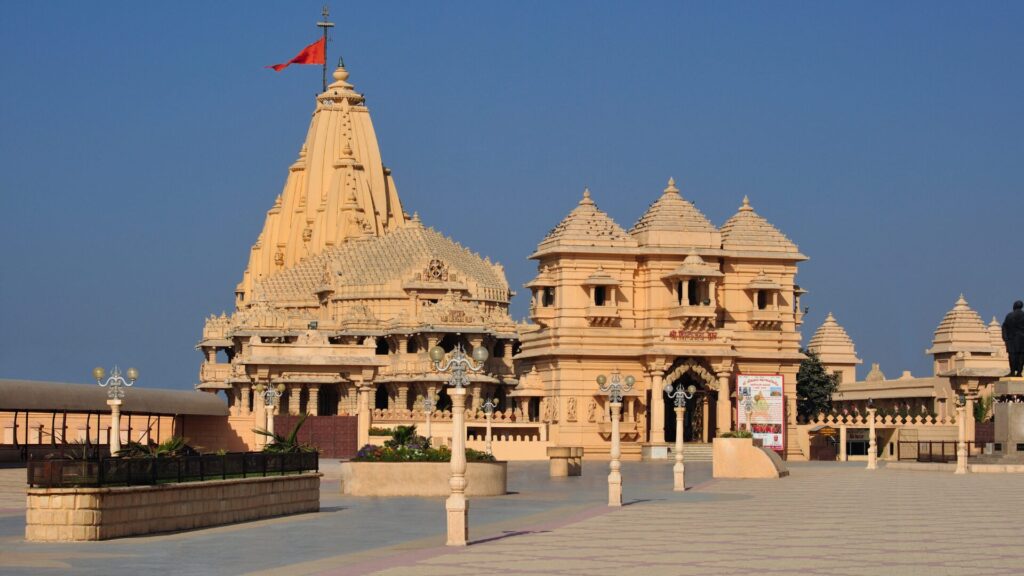
Somnath, literally means “the God of the Soma (moon)”. Soma/Chandra was married to 27 daughters of Daksha Prajapati. These daughters represent the 27 Nakshatras (lunar constellations), with whom Soma was supposed to spend an equal amount of time, moving across the zodiac in his celestial journey. However, Soma became deeply attached to Rohini, one of his favourite wives, and he neglected the others. Despite repeated pleas from his other wives and even warnings from Daksha, Chandra continued favouring Rohini, spending most of his time with her.
This disrespect and partiality angered Daksha Prajapati, who felt insulted by Chandra’s behaviour. Out of rage, Daksha cursed Chandra to wither away, leading the moon to gradually lose its luster and fade—symbolising the waning of the moon. As the moon started diminishing, the gods and Chandra’s wives realised that the curse could have disastrous cosmic consequences, disrupting the natural order of time and tides. They asked Soma to appeal to Shiva for help.
Soma visited the town of Prabhas Patan, where Shiva resided as a Jyotirlinga. Here, he bathed in the confluence of rivers Hiran, Kapila and Saraswati (not seen now). As result of bathing in the holy confluence, Shiva partially lifted the curse, allowing Chandra to wax and wane in cycles rather than disappear completely.
The temple is located in Saurashtra region of Gujarat, close to ancient port city of Veraval. It is unclear when the first version of the Somnath temple was built, with estimates varying between the early centuries of the 1st millennium and about the 9th century CE. Various texts, including the Mahabharata and Bhagavata Purana, mention a tirtha (pilgrimage site) at Prabhas Patan on the coastline of Saurashtra. But archaeological research has not found traces of an early temple. Though we found evidences of an ancient settlement there.
The temple was razed multiple times by multiple Muslim invaders and rules, most notably by Mahmud Ghazni in 1026. The temple was rebuilt each time, by different dynasties. In mid 18th century, a new temple was constructed, by Indore queen Ahilyadevi Holkar, next to the ruins of earlier existing temple. This temple stands tall even today. Post independence, a movement for reconstruction of Somnath temple was started by Sardar Vallabhbhai Patel and K K Munshi. The temple was reconstructed at the site of earlier temple, with financial support from citizen of the country. On 11 May 1951, Rajendra Prasad, then President of India performed the installation ceremony for the temple at the invitation of Munshi. The ruins and sculptures from all earlier structures are carefully preserved in multiple museums located within the town of Prabhas Patan.
2. Mallikarjuna
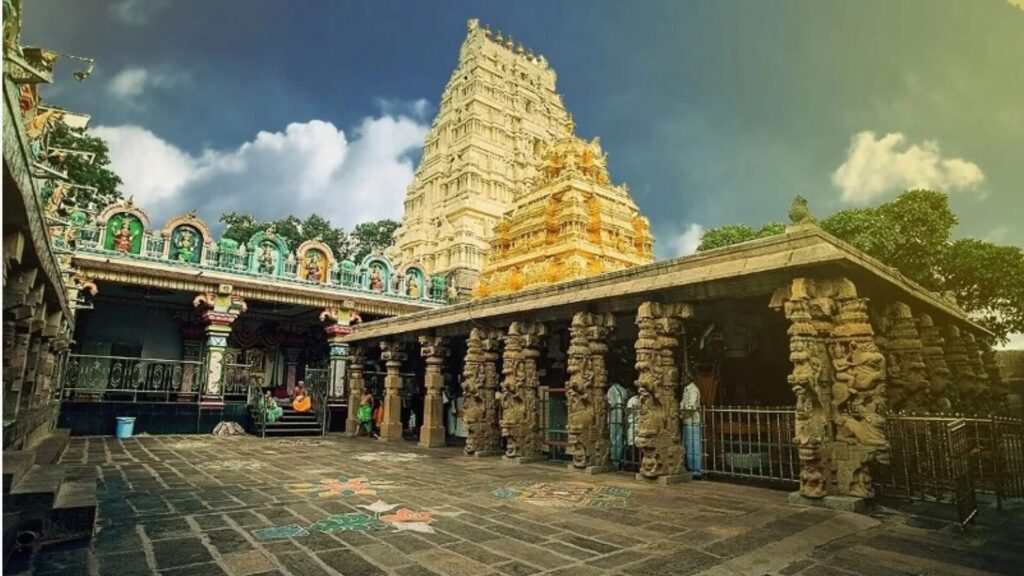
The hymn talks of second Jyotirlinga to be Mallikarjuna, situated at Srisaila. It is located at Srisailam, in Nandyal district of Andhra Pradesh. The pilgrimage place is very important to both, Shaivism and Shaktism, as the temple is dedicated to both, Shiva and Parvati. It is also considered to be one of the 18 Shaktipeethas, by the followers of Shaktism.
There are multiple legends associated with this temple. One legend talks about an Asura named Tarakasura. The region was suffering because of the deeds by Tarakasura, and the locals asked Shiva for help. Listening to the deeds of Taraksura, Shiva was very angry and he started to perform Samhara Tandava in anguish. Tarakasura, fearing Shiva’s angry form, surrendered himself and Shiva killed him. But Shiva’s rage did not come down, even after slaying Tarakasura. The deities picked up Jasmine flowers (called Mallika in Telugu) from nearby and crushed them. The juice of the Jasmine flowers was then poured on the body of Shiva, to calm him down. Shiva then settled at the place.
There is one legend associated with the sage Markandeya. Markandeya was a very powerful sage, who was destined to die at the age of 16. He mastered all Vedas and scriptures by the time he turned 16. He also became a devotee of Shiva. On the destined day of death, Markandeya was submerged in worship of Shiva. When Yamaduta came to take him, they could not. This was because of the power of devotion, that Shiva had created a protective layer around Markandeya.
When Yama himself came down to take life of Markandeya, he sprung his noose around Markandeya. Markandeya was hugging the Shivalinga at this moment, and so, the noose circled the Shiva Linga as well. Shiva was very angry because of this. Shiva appeared there, and slayed Yama (Kala). This is how Shiva got to be named Kalantaka. It is said that the Mallikarjuna hill is the place where Markandeya had worshipped Shiva.
There also a folklore about a princess named Chandravathi. Chandravathi was frightened becaue her own father was making advances towards her. She ran away and hid on a hill, to save herself from her father’s advances. While she was hiding here, she noticed a cow pouring milk on a rock. She noticed the cow do this every day. Out of curiosity, she cleaned the rock. And she was shocked to see a Shiva Linga there. She cleaned the Shivalinga and started to worship it. Because she had nothing to offer to the God, she started picking up Jasmine flowers from nearby plants, and would offer the same to shiva. It is also said that the princess built the first temple of Mallikarjuna.
Some narrate a tale of marriage of Shiva and Parvati. They believe that the marriage had taken place on the Srisailam hill, and both of them spent some time on the hills after their marriage. This is the reason why a Jyotirlinga and Shaktipeetha, both exist at Srisailam.
The local tribe of Chenchus believe Shiva or Mallikarjuna to be their son in law. They believe that Shiva was wandering in the forests as a hunter. When he was hunting, he saw one Chenchu girl and fell in love with her. He then married her, and settled on the hills with her. Because of this, they refer to Mallkarjuna or Shiva as Chenchu Mallayya.
The temple finds mention in many ancient scriptures. The earliest known mention of the Srisailam Hill is traced in Puluvami’s Nasik inscription of 2nd Century AD. However, people believe that the Srisailam worship first started during the reign of the Pallavas and continued to flourish during the rule of the Reddy Kings. Prolay Vemma and Anavema Reddy constructed pathways and Mandaps in the temple. The modern additions to the temple were made during the reign of Harihara I of the Vijayanagara Empire. There are multiple stone inscriptions in and around the temple, and in other parts of the country too, that talk about the Srisailam temple. These inscriptions provide valuable historical information about the region, including details about the rulers, their genealogy, the administration, and the social and economic conditions of the time.
With repeated attacks by multiple invaders, the temple structure faced damages. In the year 1677, Chhatrapati Shivaji Maharaj had visited the shrine. He carried out some renovations in the temple, and personally looked over the renovations. He also built a Darbar hall and Dhyan Mandir here, which was later renovated by RSS and converted to Sree Shivaji Spoorthy Kendram.
3. Mahakaleshwar
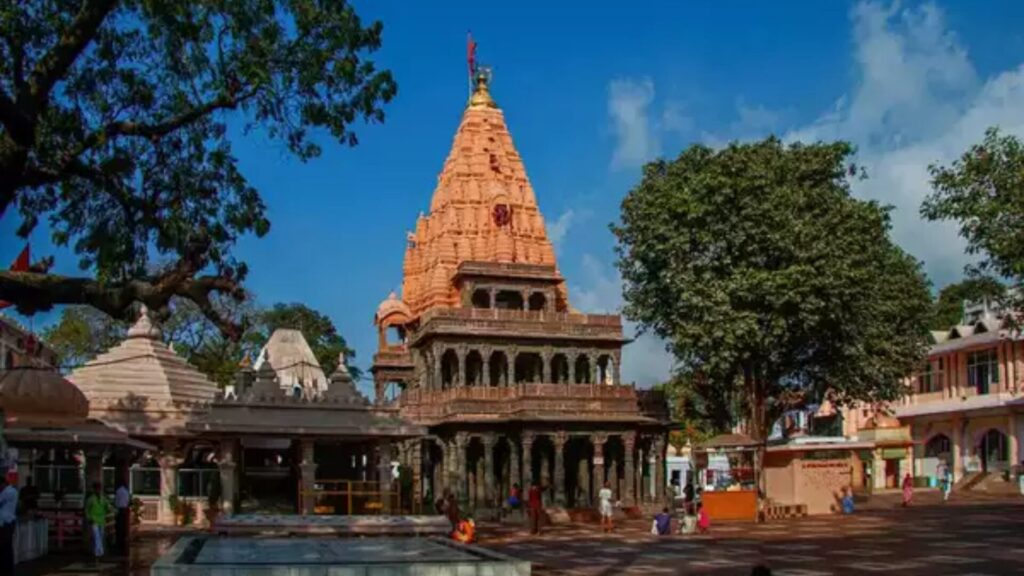
The hymn talks of third Jyotirlinga to be उज्जयिन्यां महाकाळम् . The Jyotirlinga is situated in the ancient city of Ujjain in Madhya Pradesh. The temple is situated on the banks of the holy river Shipra. Mahakalwshar, literally meaning “Great lord of time”, talks about greatness of Shiva over time.
The legends talk about a ruler of Ujjain named Chandrasena. He was devotee of Shiva and worshipped him all the time. One day, while he was chanting Shiva’s name, another devotee boy named Shikhar was passing by. He heard the chanting of Shiva’s name and rushed to temple to join the prayer. However. king’s guards forcibly threw him out of the temple and left him to outskirts of the kingdom, on the banks of river Kshipra. There he heard a conversation regarding plans by rival kings Ripudamana and King Singhaditya, to attack Ujjain. Hearing this, Shikhar started to pray to Shiva to save the king and his kingdom. When the attack happened, Chadrasena was caught off guard and was getting defeated. Hearing the plea of his devotee, Shiva came to rescue and saved the king and his kingdom. Upon request by Chandrasena and Shikhar, Shiva agreed to stay in Ujjain forever, and be the guardian deity of the city.
Garuda Purana talks about 7 holy places (सप्तपुरी), that one must visit in order to attain Moksha. Ujjain is one of these 7 holy places. Ujjain is also widely known as the venue for Sinhasth Kumbha Mela. The Kumbha Mela, an event commemorating the fall of Amrita drops on earth, is celebrated every 12 years.
The city has been one of the most prominent trade and political centres of the Indian Subcontinent from and before the time of the Satvahanas until the British colonisation. The temple of Mahakaleshwar might have existed for more than 10 centuries. The original temple structure was destroyed multiple times. Most prominent of these attacks was from Iltutmish, the third ruler of the Slave dynasty. The temple was renovated in 18th century by Maratha rulers Ranoji Shinde and Ahilyadevi Holkar. Recently, during the excavation for renovation, the remains of earlier temple structure were recovered. A study of these ruins will throw more light on the history of temple.
4. Omkareshwar
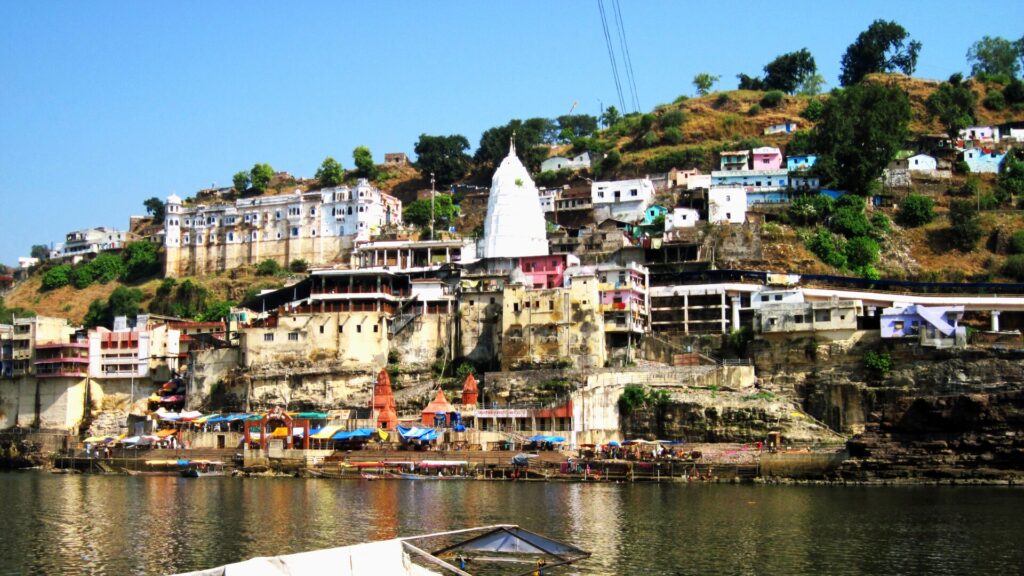
The fourth Jyotirlinga is mentioned as ओङ्कारममलेश्वरम् in the shloka. Shiva being called as Omkareshwar, emphasises his association with the sacred symbol Om. Om is the essence of the supreme Absolute, consciousness, Ātman, Brahman, or the cosmic world. Shiva, being Omkareshwar, is the lord of all these. Thus, he is the supreme one controlling everything in the cosmic world. The Shloka also talks of Mamaleshwar. Mamaleshwar means “the one who is immortal” or “lord of the immortals”. In the Omkareshwar village in Madhya Pradesh, we come across two ancient Shiva temples, one on the south bank of Narmada and one situated on an island in the river. It is believed that the two temples, combined, form the the Jyotirlinga of Omkareshwar.
There are 4 different legends associated with how the Omkareshwar Jyotirlinga came into being. First legend talks about Vindhya, the deity who had control over the Vindhyachal mountain range in the central India. Vindhya had committed some sins after coming to earth. And he wanted to propitiate himself from the sins. For this, he started to worship Shiva. He created sacred Omkar symbol with sand and clay, for the purpose of worship. When Shiva was pleased with his worship, he appeared in front of him and promised to reside in the mud mound that was created by Vindhya. Because the mound was located inside the river, Shiva promised to reside on the bank of river as well, in order to be approachable to those wo can not swim. Thus, Mamaleshwar on the southern bank of the river also became part of the Omkareshwar Jyotirling.
The second story relates to Mandhata and his son’s penance. Mandhata was a king of Ikshvaku clan (an ancestor of Ram). He finds mention in the Vana Parva, Drona Parva and Shanti Parva of Mahabharata. According to some local legends, Mandhata worshipped Shiva here, until the Lord manifested himself as a Jyotirlinga. Some scholars also narrate the story about Mandhata’s sons-Ambarish and Muchukunda, who had practiced severe penance and austerities here and pleased Shiva. Because of this, the mountain, on which Omkareshwar Jyotirlinga is situated, is named Mandhata.
The third, and little bit vague, legend talks about a war between Devas and Asuras. Devas were defeated in the war. This was a major setback for Devas and hence Devas prayed to Shiva. Pleased with their prayer, Shiva emerged in the form of Omkareshwar Jyotirlinga and defeated Danavas.
The fourth legend is related to the location of Omkareshwar Jyotirlinga. To satisfy thirst of Vindhyachal region, Parvati appeared on earth as river Narmada. But she was feeling very anxious about being away from Shiva. So she requested Shiva to be with her. Answering her request, Shiva created an island inside Narmada river, and resided there.
The Jyotirlinga of Omkareshwar is situated on a hill named Mandhata, on an island. The island is situated at confluence of Narmada and Kaveri river (not to be confused with Kaveri river that flows in Karnataka and Tamilnadu). Ancient texts like Matsya Puran, Kurma Purana, Padma Purana and Narmada Mahatmya talk about this temple. Which proves the existence of the temple from a long time. Also copper plate grant of Jayasimha of Dhara (dated 1055 CE) tell us that the temple existed before that. The temple structure is said to have been built by the Parmar kings. Chahuan rulers took over the administration of the temple after Parmars. The temple was destroyed a few times by inavdors, most notably by Mahmud Ghazni in 13th century. In the 19th ventury, the temple was rebuilt by Holkars (the rulers from Maheshwar, and later Indore).
5. Vaidyanath

The fifth Jyotirlinga is mentioned as परल्यां वैद्यनाथं . The name Vaidyanath (also referred as Baidyanath) means “the Master of Medicine”. This name establishes Shiva’s association with the practice of medicine. We all associate Dhanvantari with medicine. However, many tantric sects consider Shiva to be the creator of Ayurveda, the medical practice that focuses on preventive medicare more than curative medicare. During Samudra Manthana, Shiva had drunk the poison Halahal, which could have destroyed whole earth. And he managed to contain in one corner of his throat. This act would require a thorough knowledge of internal circulation system of body. Thus, establishing Shiva’s association with anatomy and medical knowledge. Shiva is also thought to have taught meditation to the world. Meditation plays a very vital role in preventive medicare and Ayurvedic practices.
The legend of Baidyanath is related to the mighty king of Lanka, Ravana. Ravana had gone to Kailasha to meet Shiva. When he came across Shiva, Ravana requested Shiva to reside in Lanka and bless the kingdom. Shiva manifested himself in form of a Jyotirlinga and handed it over to Ravana. However, while handing over, Shiva put a condition. The condition was that Ravana should not place the Linga on land before reaching Lanka. Ravana started to walk with the Linga. On the way, he felt urgent need to urinate. He saw a man walking nearby. He requested the man to hold the Linga for few minutes. The man was Vishnu in disguise. All Gods wanted the Linga to not reach Lanka. And they had asked Vishnu to get this task done.
As Ravana left for urination, Vishnu put the Shivlinga down. When Ravana came back, he was very angry and agitated to see the Linga been kept down. He tried to lift it, but the Shivlinga didn’t move even an inch, despite all efforts. Ravana realised that there is no way he would be able to take this Linga to Lanka. He worshipped Shiva at the place where the Linga had touched the ground. And he also built a small temple there, before leaving for Lanka. The Linga started to be worshipped as Vaidyanath.
Interestingly, Ravana is known for his contributions to Ayurveda. He wrote several books on medicine and other scientific topics, including: Ravana Samhita: A book on astrology; Arkaprakasha: A book on Siddha medicine and pharmacology; Nadipariksa: A book on pathology and clinical examination; Kaumartantra: A book on pediatrics and Marmavijnana: A book on surgery. The Shivlinga that is associated with Ravana is also called as Vaidyanath, probably owing to Ravana’s contribution to Ayurveda.
There are two contradicting views about the location of Vaidyanath Jyotirlinga. The term परल्यां वैद्यनाथं , according to many scholars, refer to a place called Parali in Maharashtra’s Beed district. Some scholars believe the Jyotirlinga to be situated at Deogarh in Jharkhand. I will introduce you to both the places in this book. Ultimately, it is the devotion that matters, and not the location.
The town of Parli is mentioned in a 10th century handwritten document named “Kalpasamuha”. The document is in collection of a Shastri in Ujjain. The document talks about some researchers in medicine traveling to Vaidyanath in search of some rare and unique medicinal plant. This showcases the importance of Parli as a place of medical value, highlighting the Vaidyanath form of Shiva. Many inscriptions from Rashtrakuta, Kalyani Chalukya and Yadav era have been found in nearby regions. The towns of Ambejogai and Dharmapuri (both within 25 km radius of Parli) are mentioned in multiple inscriptions. The present temple is built by Ahilyadevi Holkar, in 18th century. Previous existing temple might have been destroyed by invadors in 14th century, like many other temples in the region.
Second location, that people commonly associate with Vaidyanath Jyotirlinga is Deogarh in Jharkhand.
The Dwadasha Jyotirlinga Stotram by Shankaracharya talks about the Baidyanath Jyotirlinga as
पूर्वोत्तरे प्रज्वलिकानिधाने
सदा वसन्तं गिरिजासमेतम्।
सुरासुराराधितपादपद्मं
श्रीवैद्यनाथं तमहं नमामि।।5।।
Based on this line, the Vaidyanath Jyotirlinga is ssituated in North-Eastern side of Bharatvarsha. Because Parli is situated on the central part of Bharatvarsha, scholars believe that Deogarh might as well be the spot where the Baidyanath Jyotirlinga is situated. The verse also says that Shiva resides along with Girija (Parvati) at the Vaidyanath Jyotrilinga. Because Deogarh is also a Shaktipeeth, locals and a a section of scholars attribute Deogarh as being the place of Baidyanath Jyotrlinga.
Siva Puran Koti Rudra Samhita (verse 1/21-24) identifies the Jyotirlinga as “Baidyanatham chithabhoomau”. According to which Baidyantham is in ‘chidabhoomi’, which is the ancient name of Deoghar.
The original temple complex here might have been built around 13th century, with many additions and adulterations over time. The recorded history about the temple is only available from 1757, when East India Company officer Mr Keating was sent to look after the temple, after the battle of Placy. The officer took the control of temple for a few years, but later handed over The temple complex comprises of central shrine dedicated to Shiva, and 21 other subshrines.
The Navlakha temple, situated at around 4 km from Baidyanath temple, is also a very beautiful temple to explore. The temple construction had started with a first donation of nine lakh Rs from queen Charushila of Pathuriaghata, a royal family from Kolkata. Hence the name Navlakha temple.
6. Bhimashankar
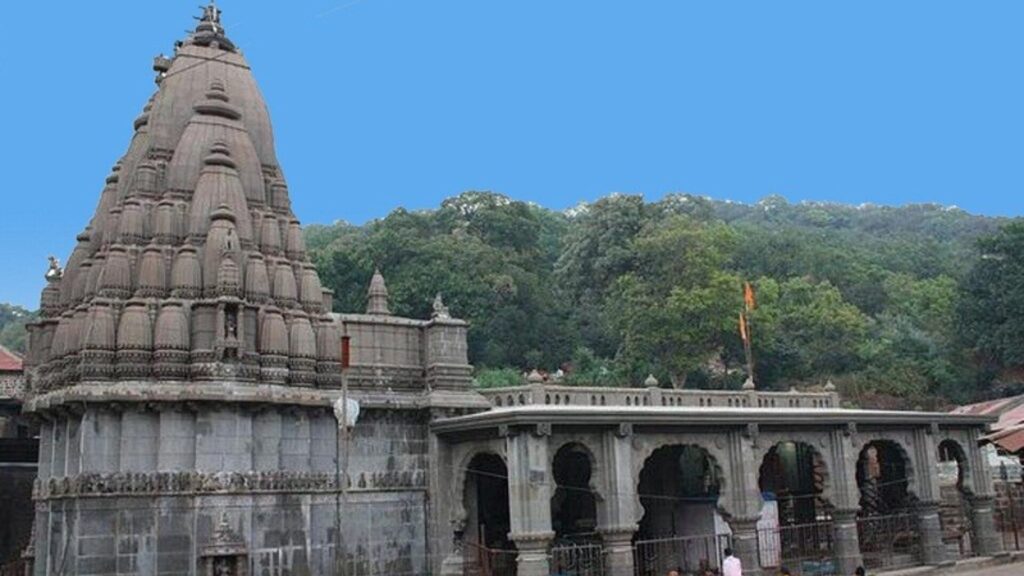
The sixth Jyotirlinga is named Bhimashankar, literally meaning the Shiva with Bhima. Bhima is name of a river that originates from a point very close to the temple. The river flows through parts of Maharashta and merges with Krishna river, near Raichur in Karnataka.
The legend of Bhimashankar temple also talks about a warrior named Bhima (not to be confused with Bhima in Mahabharata). This Bhima was son of Kumbhakarna, and wanted to take revenge of his father’s killing. He did penance of Shiva, and received a boon from Shiva. Blinded by the power provided by the boon, he went on to create a rampage. While destroying many kingdoms, he came across a king named Kamarupehsvar , who was a devotee of Shiva. Bhima ordered him to stop worship of Shiva, but the king refused. Out of rage, Bhima kept him captive in a prison. The king created a Shivlinga using sand and started to worship Shiva there, inside prison. When Bhima tried to destory the Linga, Shiva appeared there and killed the warrior, blinded by power.
Another legend about the temple talks about a demon named Tarakasura, who was killed here by Shiva.
The temple is situated on edge of a hill in Sahyadri. It is not known when the first temple was built. But archaeological and scriptural references point towards existence of this temple in 13th century. In 1437 AD, a Pune-based Sahukar (trader) called Chimaji Antanji Nayik Bhinde built a court hall in the temple.
Some parts of the temple were renovated later on during Maratha reign in the 18th century. It is said that Nana Phadnavis, a powerful politician in the Peshwa era, built the Sabhamandap and the Shikhara of the temple that reflec modern architectural style prevalent in that period.
Chimaji Appa (brother of Bajirao I) donated a big bell to the temple, which is visible in front of the temple. This is one of the many Portuguese colonists’ church’s bell, which Chimaji Appa and his army brought from Vasai as souvenirs after defeating the Portuguese at the Battle of Baçaim on February 1739.
In the vicinity of Bhimashankar Jyotirlinga, one can visit Ganesha temple at Lenyadri (one of the Ashta Vinayakas) and Parvati temple as Shivai at the Shivneri fort (birthplace of Chhatrapati Shivaji Maharaj). The local belief is that Shiva, Ganesha and Parvati reside here on these three hills, to overlook the whole Sahyadri range.
The village of Kharosi was granted to the temple by Chhatrapati Shivaji Maharaj. The daily religious observance was funded through the financial resources derived from the people of the area.
Recently, there was a controversy regarding the location of Bhimashankar Jyotirlina. While Dakini is name of a tribe that used to reside in the region; there is a hill range named Dakini near Guwahati in Assam. In the hill range, a Shivlinga positioned amidst the cascading waterfall. One advertisement by Assam Government, calling this Shivlinga as Bhimashankar Jyotirlinga, had stirred a controversy.
7. Rameswaram
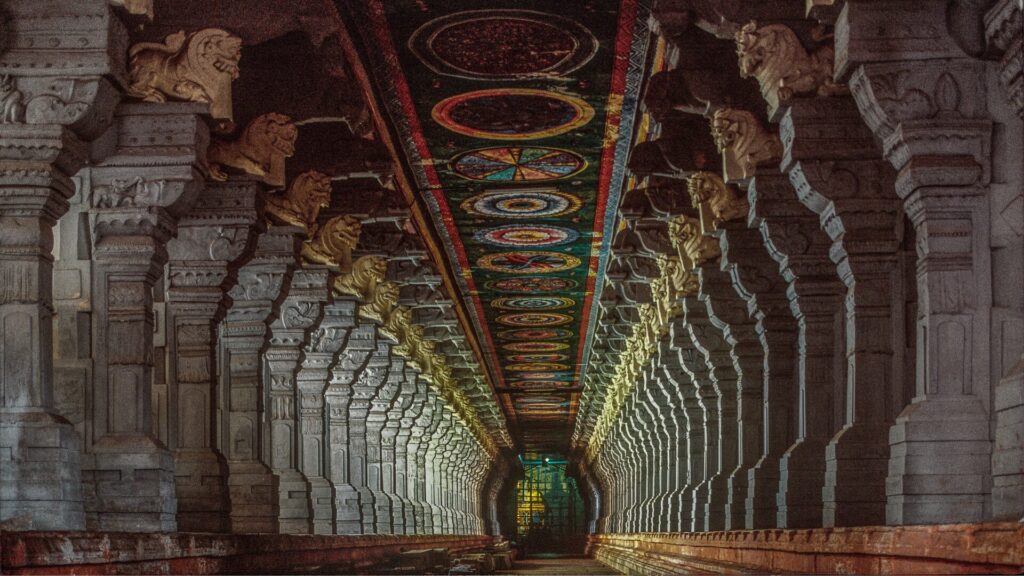
The seventh Jyotirlinga is described as सेतुबन्धे तु रामेशं. Literal translation of Ramesh is “The deity of Rama”. Setubandhe would mean “the place where bridge was built”. The most prominent bridge in out ancient literature, is the one that was build by Rama, while on mission to rescue Sita. This bridge connects Pamban Island, also known as Rameswaram Island, off the southeastern coast of Tamil Nadu, and Mannar Island, off the northwestern coast of Sri Lanka.
Rama, being an incarnation of Vishnu, is very important part of Vaishnavite traditions. By linking Rama to Shiva, an attempt has been made to build a bridge between Shaivites and Vaishnavites. So the word “Setubandhe” has two different expositions.
The legend of this temple talks about the war in Lanka and the regret Rama was facing after that. Ravana was the son of a Rishi, and a very scholar person. Rama had to kill Ravana to rescue his abducted wife. But Rama was feeling guilty of killing a Brahman. When he entered the land of Bharata, he wanted to repent. For repenting, Rama decided to worship Shiva at the place. He asked Hanuman to fly to Kailash and bring a Shivlinga from there, for him to worship. Hanuman flew to bring the Shivlinga, but it took him long time to come back. In the meanwhile, Sita created another Shivlinga with the sand from seashore. Ram and Sita worshipped this Shivlinga made by Sita.
When Hanuman came back with Shivlinga, he was upset to see that Rama had already worshipped Linga, without waiting for Hanuman to return. Hanuman placed the Shivlinga nearby. Rama made sure to worship both the Shivlingas before he left. Even today, the temple at Ramewaram has both the Shivlingas installed.
The temple in its current form is said to have been built in the 17th century, by King Kizhavan Sethupathi or Raghunatha Kilavan of the Ramnad / Maravar kingdom. Though, some parts of the temple showcase the evidences of an earlier temple structure existing from 11th or 12th century (Pandya era). The Jaafna kings of the Pandya dynasty have also contributed significantly to the temple.
The village of Pappakudi was given as a grant to Rameshwaram Temple by Nayak king Perumal Servaikaran in 1667 CE. The Maratha rulers of Thanjavur had built multiple rest houses in the region, between the years 1745 and 1837.
Rameswaram is also among the 275 Paadal Petra Sthalams in India. These are places where revered Shaivaite saints like Appar, Sundarar, and Tiruguna sang glorious hymns of Shiva. Historical evidence claims that Swami Vivekananda also visited the Rameswaram temple before his tour to Chicago.
The Rameswaram temple is also one of the destinations of the Char Dham Yatra, which is a pilgrimage of the highest ranks in Hinduism. The temple houses 22 teertham (water tanks). Many devotees make it a point to take bath with water from each of these teerthas. It is said that the water from first 10 teerthas remind the devotee of all the wrongs he has committed in life, and the remaining 12 teerthas provide him enlightenment to ride over the sins and live a peaceful life ahead.
8. Nageshwara
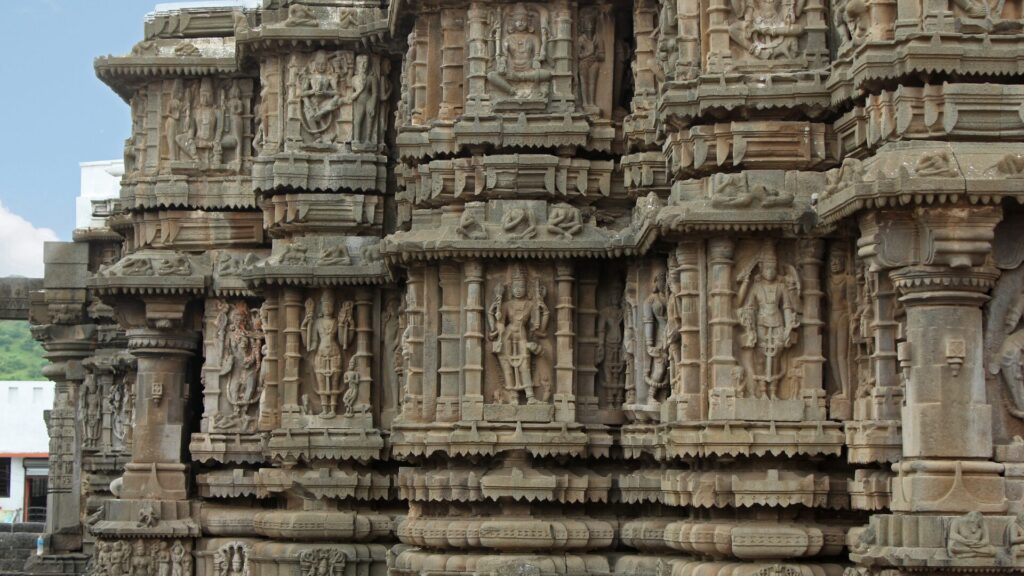
The eighth Jyotirlinga is termed as नागेशं दारुकावने . The names Nageshwara or Nagnath talks about Shiva being the God of serpents. Shiva is closely associated with Nagas or the Serpents. Shiva has a Naga around his neck, he had drunk the deadly venom Halahal, that some consider to have been spitted by Vasuki, the snake used for Samudra Manthan. The fact that the deadly venom did not affect Shiva negatively, emphasises he being the Nageshwar.
The legend associated with Nageshwar Jyotirling talks of a demon named Daruk, who wanted to worship and please Shiva. He approached a Shiva devotee named Supriya. But Supriya refused to teach him how to worship Shiva, fearing that Daruk may trouble sages and devotees, if he gets power from Shiva. Filled with anger, Daruk imprisoned Supriya and other devotees. The prisonors started to chant “Om Namah Shivay” inside the prison. Shiva appeared there and killed the demon, and saved the devotees.
There are multiple opinions about where the Nageshwara Jyotirlinga is situated. The Shloka talks about a forest named Darukavan. Some scholars consider that Darukavan means the forest around the ancient city of Dwaraka. Hence, they talk of the Nageshwar temple near Dwaraka to be the Jyotirlinga.
The Kotirudra Sanhita talks about the Jyotirlinga as
पश्चिमे सागरे तस्य वनं सर्वसमृद्धिमत् ।
योजनानां षोडशभिर्विस्तृतं सर्वतो दिशम् ॥ ४ ॥
This Shloka gives the location of Nagheshwar to be on the western shore of land, near the sea. This description matches well with the location of Nageshwar temple near Dwarka.
The temple is built recently, and there are no evidences that talk about the existence of the temple in ancient or medieval times. However, there are multiple other places in region, that are centuries old. Being close to Dwaraka, the temple is visited by lakhs of devotees every year.
Other location that is associated with the Nageshwar is Aundha in Maharashtra’s Hingoli district. The Seuna Yadav dynasty is credited to have built this temple in 13th century. The temple walls are adorned with many beautiful sculptures, depicting various deities, Surasundaris, Matrikas and stories from epics and Purana.
The temple features in the list places Gurunanak Dev have visited, during his travel in the region. There are also accounts of visit by various saints from Bhakti Sampradaya. These include Namdev, Jnaneshwar, Visoba Khechar etc.
One interesting aspect of this temple is that the Nandi of the temple is on the back side of temple, and not on the entry of the temple. Locals tell an interesting story about this.
Once saint Namdev was singing Bhajans, sitting in front of the temple. The temple priests were performing Pooja inside temple, and they asked Namdev to sing Bhajans someplace else, because the priest was getting disturbed. Namdev and his fellows moved and stared to sing Bhajans on the backside of temple. The deity was liking the Bhajans so much, that the deity shifted his direction. As a result, whole of the temple also moved its direction, in order to face Namdev. That’s how the entry of the temple changed, and Nandi is on the backside of the temple.
During renovation work of a temple tank behind temple, a very beautiful Vishnu idol was discovered. The idol is now kept in the Mandapa of the temple. The outer walls of the temple also feature many Vishnu related sculptures. This beautiful confluence of Shavisim and Vaishnavism is a result of the socio-cultural composition of the era.
The word Darukavan may also mean a forest of Devdaar trees. Near Almora in Uttarakhand, we come across a forest of Devdaar trees, with ancient temples situated inside this forest. Jogeshwar, an historical town in this forest, consists of more than 125 ancient temples. Locals believe that Jogeshwar is the location of the Nageshwar Jyotirlinga.
9. Vishwanath
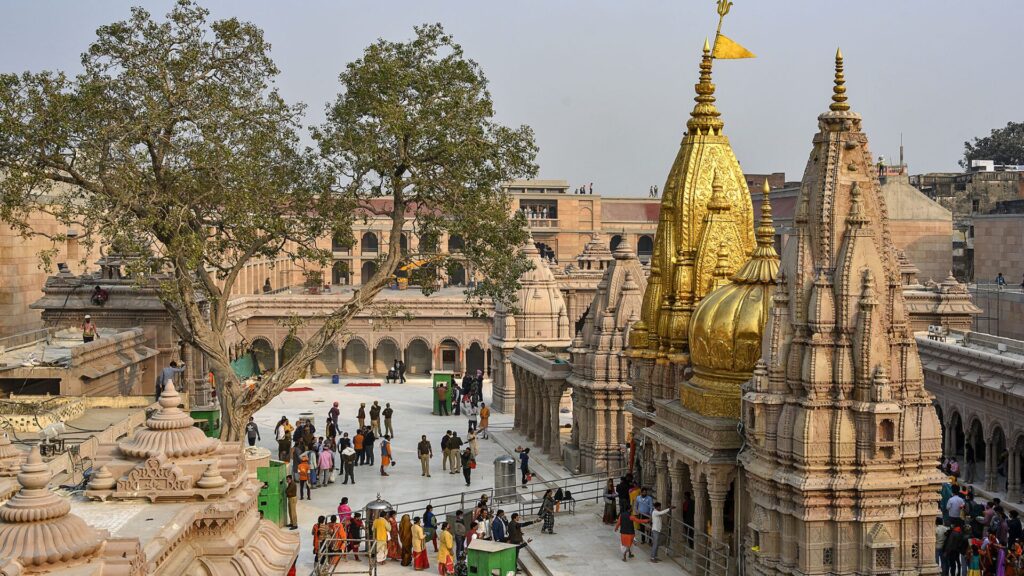
The nineth Jyotirlinga is termed as वाराणस्यां तु विश्वेशं. It gives out location of the Jyotirlinga as Varanasi. Vishweshwara or Vishwanath means “The lord of the universe”. This term places Shiva as being the most important deity in Hinduism.
Kashi or Varanasi is believed to be the oldest city that continues being inhabited. Excavations in 2014 led to the discovery of artefacts dating back to 800 BCE. Further excavations at Aktha and Ramnagar, two sites in the vicinity of the city, unearthed artefacts dating back to 1800 BCE, supporting the view that the area was inhabited by this time. The celebrated Chinese traveller Xuanzang also visited the city around 635 CE, and has provided a detailed information about Varanasi from that time.
The tale of goddess Annapurna is associated with the town of Kashi. Once, Shiva and Parvati had an argument about the materialistic world and needs. Shiva was saying that these needs, including the food humans ate, are just an illusion and do not matter. Parvati, being the governing deity of the materialistic aspects, was infuriated by Shiva’s words. To show her worth to Shiva and all others, she disappeared. With her disappearance, the whole world was deprived of food and witnessed a famine.
Shiva’s followers begged him for food; even the Gods were forced to beg for food, but could not find any food. Finally, Shiva and his followers realised that there was only one kitchen on earth, in the city of Varanasi (Kashi), where food was still available.
Shiva went to Kashi to beg for food. To his surprise, the kitchen was owned by his wife Parvati, but in the form of Annapurna. She was seated on a throne, serving and distributed food to the starving gods and hungry inhabitants of the earth. Annapurna offered her food as alms to Shiva and made him realize that as Brahman, Shiva might have outgrown hunger; but his followers had not.
Many ancient scriptures talk about the town of Kashi and its presiding deity Vishweshwar. The Skanda Purana contains a part titled “Kashi Khanda”, while the Brahmavaivarta Purana includes a portion known as “Kashi Rahasya”, both of which are dedicated to the city of Varanasi.
Kashi Khanda describes the original Vishweshwara temple in much detail. It talks about a temple with 4 mandapas, and a huge Shivlinga placed inside the Garbhagriha. The four mandapas include the Jnana mandapa located to the east, the Ranga mandapa to the west, the Aishvarya mandapa to the north, and the Mukti mandapa to the south. The temple was destroyed multiple times, and reconstructed each time.
The original Vishwanath temple was destroyed by the Ghurids in 1194. In 1230, the temple was rebuilt near the Avimukteshwara Temple, away from the main site, during the reign of Delhi’s Sultan Iltutmish (1211–1266). It was demolished again during the rule of either Hussain Shah Sharqi (1447–1458) or Sikandar Lodi (1489–1517). Raja Man Singh started rebuilding the temple during Akbar’s reign. In the seventeenth century, during the rule of Jahangir, Vir Singh Deo completed the construction of the earlier temple.
In 1669, Mughal Emperor Aurangzeb destroyed the temple and built the Gyanvapi Mosque in its place. The remains of the erstwhile temple can be seen in the foundation, the columns, and the rear part of the mosque.
In 1742, the Maratha ruler Malhar Rao Holkar devised a plan to demolish the mosque and reconstruct the Vishweshwar temple at the site. However, his plan did not materialise, partly because of the intervention of the Nawab of Awadh, who was given control of the territory. In 1750, the Maharaja of Jaipur commissioned a survey of the land around the site with the objective of purchasing land to rebuild the Kashi Vishwanath temple, which in turn failed. In 1780, Malhar Rao’s daughter-in-law, Ahilyadevi Holkar, built the present temple adjacent to the mosque. In 2021, a major redevelopment of the temple complex was completed, and the Kashi Vishwanath temple was connected to the Ganga river .
10. Trimbakeshwar
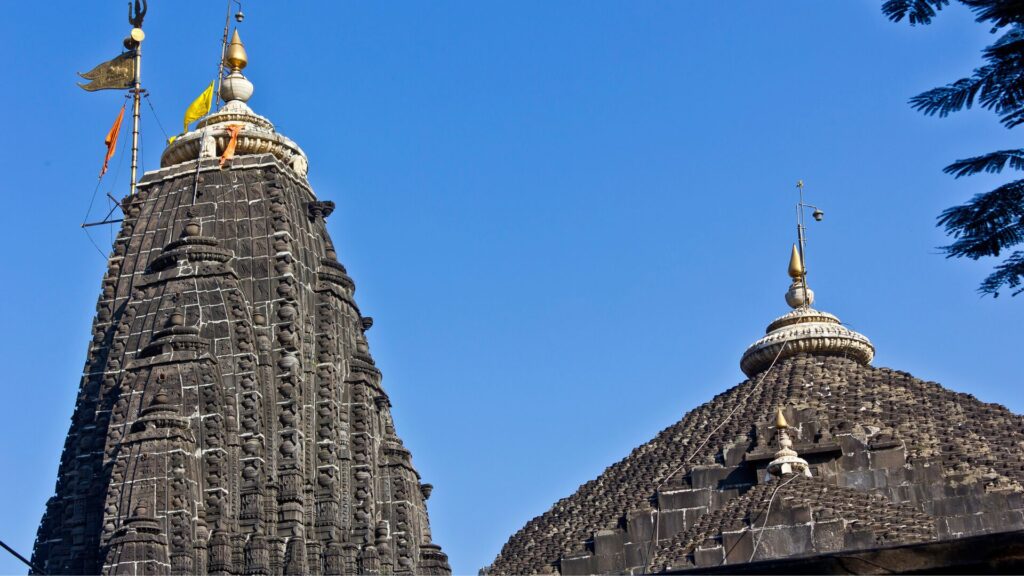
The tenth Jyotirlinga is termed as त्र्यंबकं गौतमीतटे. Many ancient scriptures describe Godavari river as Gautami. Because of religious and cultural significance of the Godavari river, the river is called as Ganga of the South or Dakshin Ganga. (Even Kaveri is sometimes referred with this name). The Jyotirlinga of Trimbakeshwara is located near the source of Godavari river, in the village Trimbak, near Nashik in Maharashtra.
The legend of the temple is closely related to the legend associated with Godavari river. Sage Gautam is said to have lived on the Brahmagiri hill, along with his wife Ahilya. Once, there was a major draught in the region and the villagers were dying because of shortage of food and water. To ease their pain, Gautam requested rive Ganga to come to the region. But she was reluctant. Gautam performed penance to please Shiva. Pleased by his penance, Shiva directed Ganga to flow in the region. Ganga emerged here, as a new spring, in the form of Godavari. Shiva then resided in the form of Linga, at the place where he had appeared for Gautam.
One of the prominent feature of this temple is the existence of three faces, embodying Brahma, Vishnu and Shiva. Due to the Abhishekam over the centuries, the linga has started to erode. Now, the Abhishekam is performed by placing a gold mask of Trideva, over the Shivlingam, in order to save the lingam from further erosion.
The name Trimbakeshwar means “The lord of three Ambikas”. Ambika is synonym for Shakti. So the trimbakeshwar is the lord of three Shaktis or powers, in the form of Brahma, Vishnu and Mahesh. Interestingly, Shiva is sometimes also referred as Trilokeshwar, the lord of three universes.
The original temple here, is said to have been built in the 10th century. But prior to that, a 6th century inscription in Anjaneri talks about a donation given to a temple. Though, it is not known which temple is being referred in the inscription. The temple faced multiple attacks and destructions, most prominently in the times of Aurangzeb. Aurangzeb razed the temple and built a mosque at the place. In the year 1751, Nanasaheb Peshwa won over the region and built the temple again.
Nearby city, Nashik, has a very significant role to play in Ramayana. The Panchvati, where Ram, Lakshmana and Sita had stayed in the final stretch of their exile, is modern day Nashik. This is the place where Sita’s abduction had taken place. Nashik and Trimbakeshwar are also venue of Kumbha Melas. Until 1789, Trimbak used to be venue of Kumbha Mela. After war between Shaivite sanyasis and Vaishnavite bairagis over order of precedence of bathing; two different venues as Nashik and Trimbak were created by intervention of the Peshwas.
11. Kedarnath
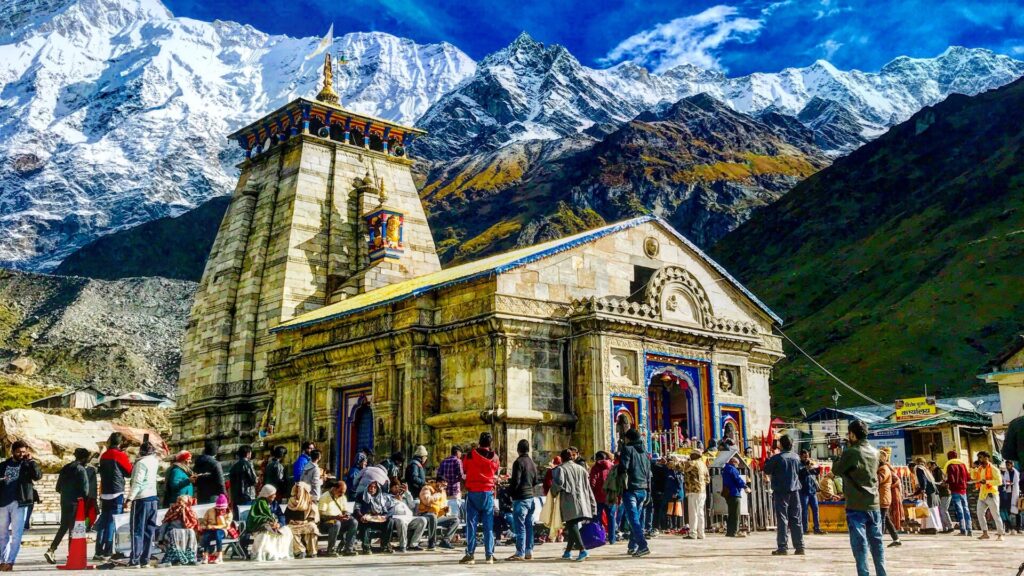
The eleventh Jyotirlinga, Kedarnath, is situated in the Himalayas, near the river Mandakini. Kedarnath, literally means “The lord of the field”. Due to extreme weather conditions, the temple is open to the general public only between the months of April (Akshaya Tritiya) and November (Kartik Purnima). During the winters, the vigraha (deity) of the temple is carried down to Ukhimath to be worshipped for the next six months.
In the Garhwal hill range of Himalayas, there are 5 Shaivite temples, known as Panch Kedar. Kedarnath is the first among these 5. The legend associated with Kedarnath and the Panch Kedar relates to Pandavas, the mighty warriors from Mahabharata. The Pandavas wanted to atone for the sins committed during the Kurukshetra war. They handed over the reins of their kingdom to their kin and left in search of the Shiva and to seek his blessings. Shiva, wanting to avoid them, assumed the form of a bull (Nandi). Bhima saw the bull grazing near Guptakashi (“hidden Kashi” — the name derived from the hiding act of Shiva). Bhima immediately recognized the bull to be Shiva. Bhima caught hold of the bull by its tail and hind legs. But the bull-formed Shiva disappeared into the ground to later reappear in parts, with the hump raising in Kedarnath, the arms appearing in Tungnath, the face showing up at Rudranath, the nabhi (navel) and stomach surfacing in Madhyamaheshwar and the hair appearing in Kalpeshwar. The Pandavas built temples at the five places for venerating and worshipping Shiva. These five places are collectively known as Panch Kedar.
A variant of the same legend tells that Bhima caught the bull and stopped it from disappearing. The bull was torn apart into five parts and appeared at five locations. After building the Panch Kedar Temples, the Pandavas meditated at Kedarnath for salvation, performed yagna (fire sacrifice) and then through the heavenly path called the Mahapanth (also called Swargarohini), attained heaven or salvation. Even though the legend of the temple is associated with Mahabharata, Mahabharata does not mention about Kedarnath anywhere. The first reference of the places is available in Skanda Purana. The Skanda Purana talks about the place, in reference to the source point of Ganga and places around it. The exact timeframe of building of Kedarnath temple is not known. Though the temple is said to have existed for many centuries. Adi Shankaracharya, the 8th century philosopher is said to have died near Kedarnath temple. Kedarnath was definitely a prominent pilgrimage centre by the 12th century, when it is mentioned in Kritya-kalpataru written by Bhatta Lakshmidhara.
12. Grishneshwar
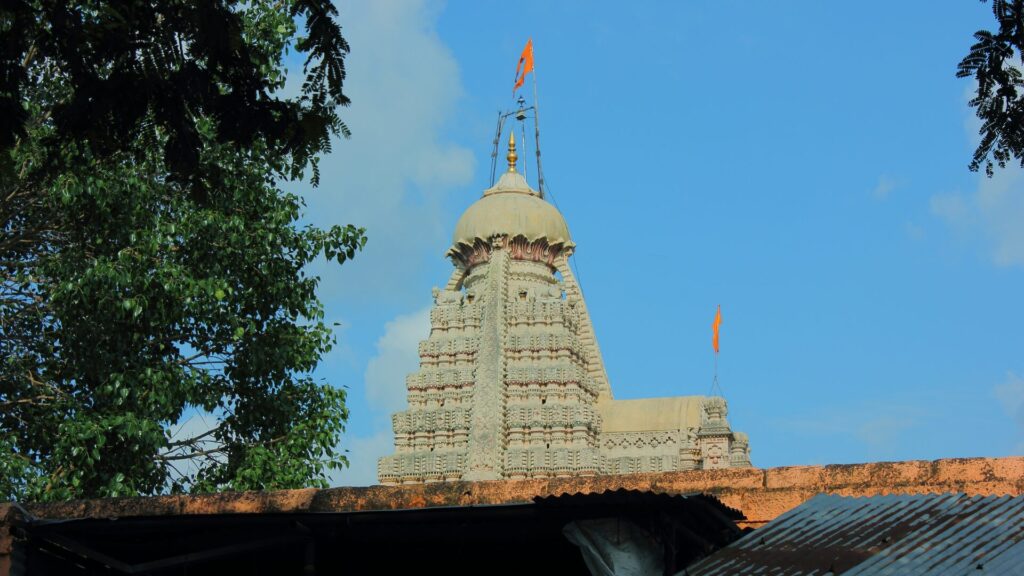
The 12th Jyotirlinga is named as Ghushmesha, which means lord of compassion. The temple is located in Verul village of Chhatrapati Sambhajinagar district (earlier known as Aurangabad) of Maharashtra. The legend of Grishneshwara talks about a Brahmin couple named Sudharma and Sudeha, who lived near the Devgiri mountain. They had a lot of love for each other, but did not have a child. The astrologer predicted that no child will ever take birth from Sudeha’s womb. Sudeha, eager to have a child, asked Sudharma to marry her younger sister. Sudharma reluctantly agreed to it. Her younger sister, Ghushma was a devotee of Shiva. She would create 101 Shivlinga out of sand everyday. She would worship them and immerse them in a nearby pond everyday. Soon, a child was born from her womb and the family was very happy. As time passed, evil thoughts started to arise in Sudeha’s mind. She started to get possessive about her husband, and could not live with the fact that the child born was not hers but Ghushma’s. Influenced by the evil thoughts, she one day killed the young child while he was asleep. And she threw his body in the same pond, where Ghushma used to immerse Shivlingas everyday. Next day, the news of the death spread around. But Ghushma was unaffected by what happened. She got to Shiva worship like everyday. She created the Shivlingas and worshipped them. When she was going to immerse the Lingas in the pond, her son came running. At the same time, Shiva also appeared there. Filled with rage for Sudeha’s act, he wanted to kill her. But Ghushma stopped Shiva from this act. She requested Shiva to forgive her sister. And she also requested Shiva to live at this location, to bless his devotees. Because Ghushma’s compassion pacified Shiva’s rage, Shiva came to be known as “Ghrishneshwar” or “Lord of the compassion”. The region of Devgiri held a lot of cultural and political importance in ancient as well as medieval era. The Devgiri fort (also referred as Daulatabad) was capital of Yadava kingdom. The site of Ellora caves is also at 1 km from the Grishneshwar temple. The village Yellapur (today’s Verul) is also mentioned as capital of one of the branches of Rashtrakutas.
Considering the history of the region, and existence of multiple ancient temples in region, it would not be wrong to assume that the original temple here existed for atleast 10 centuries. There are stone inscriptions that talk of existence of temple here in 7th century. However, we do not know exactly if it was a small shrine or big temple. The temple was destroyed multiple times. The temple structure was destroyed by the Delhi Sultanate in 13th and 14th centuries. Maloji Bhosale, grandfather of Chhatrapati Shivaji, restored it in 16th century. The temple went through several rounds of rebuilding followed by re-destruction during the Mughal-Maratha conflict. It was rebuilt to its current form in the year 1729 under the sponsorship of queen Gautama Bai Holkar of Indore, after the fall of the Mughal Empire. The temple showcases amazing blend of Kalyani Chalukya architecture and Maratha architecture. Historians believe that this blend happened because the Maratha built the temple over existing structure, rather than entirely rebuilding it. One special feature of the temple is the Nagnath library here. The library contains many rare books, copper plates and palm leaf inscriptions. The library is a source of very important historical information for the researchers.
